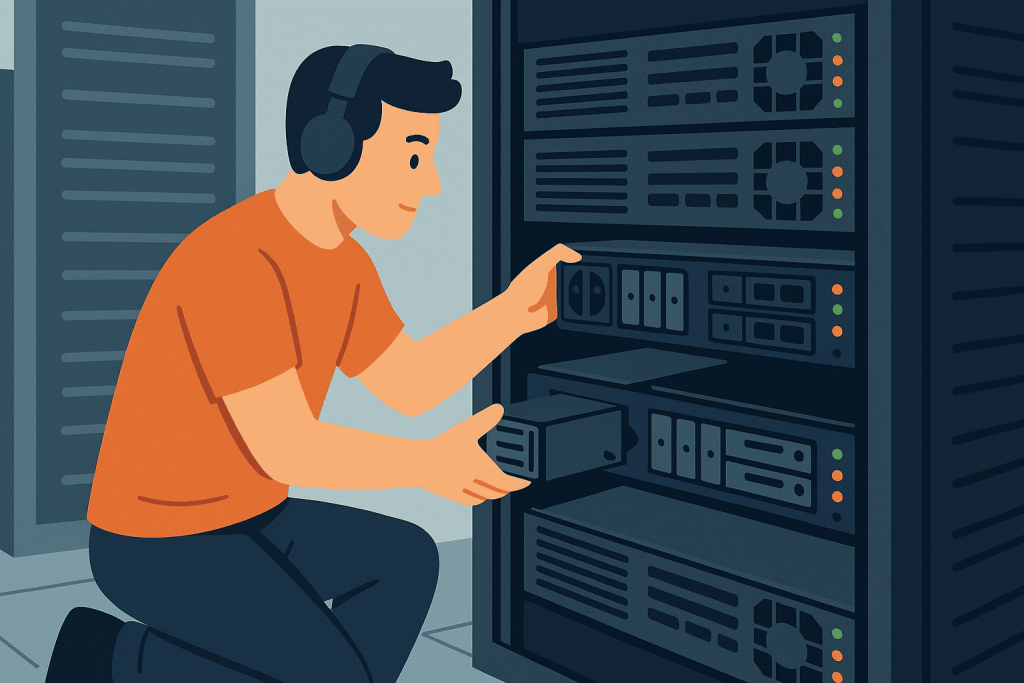
In a world where business processes operate continuously and online services are available to users 24/7, the stability of servers becomes one of the key success factors. A website may receive thousands of visitors per day, a CRM system serves managers in real time, and financial transactions take place every second. Under such conditions, even a short downtime can have significant consequences: from halted sales and disrupted internal processes to loss of reputation and customer trust. That is why modern servers are designed to remain operational even during maintenance. One of the technologies enabling this is the ability to hot-swap disks and power supplies.
What is hot swap and why it matters
Hot swap is the ability to replace a server component without shutting down the system. This means the hardware is physically removed and installed while the operating system continues running, without interrupting applications, user requests, or network operations. In servers, hot swap support is implemented through special slots, controllers, and power and data bus management mechanisms.
For administrators and users, this means that if an individual component fails, there is no need for an urgent reboot or emergency shutdown of the server. The system continues to operate, and the component is replaced calmly and predictably. This is critical for businesses that cannot afford service interruptions.
What a RAID array is and how it ensures fault tolerance
RAID (Redundant Array of Independent Disks) is a technology that combines several physical disks into a single logical system with increased reliability, performance, or both. The idea of RAID is that data is duplicated or distributed across disks so that if one fails, the information remains available.
For example, RAID 1 creates a complete mirror of data on two disks. If one disk stops working, the server automatically continues running on the second. RAID 5 uses parity calculations and allows one disk to fail without data loss, as the information can be reconstructed. RAID 6 can tolerate the failure of even two disks.
When one disk in such an array fails, the controller simply removes it from the array. The administrator replaces the faulty disk with a new one, and the system automatically rebuilds the data on it using stored copies or parity information. During all this time, the server continues to operate, and users do not notice any changes.
The process of replacing disks without stopping the server
Server chassis typically have a front panel with special drive bays. Each bay is labeled, equipped with a handle for easy removal, and has status indicators that show whether it is safe to remove the drive.
The administrator identifies the faulty disk using the controller or monitoring system, removes it, and installs a new disk of the same or larger capacity. Then the rebuilding process begins, during which the RAID controller or software RAID transfers data to the new drive.
During rebuilding, the array operates under increased load, so it is recommended to perform the replacement during periods of minimal user activity. However, the server continues to perform its functions.
Replacing power supplies without interrupting operation
Servers often use two or more power supplies combined into a single system to ensure continuous power. Each supply is capable of powering the server independently. This is known as redundancy.
In normal operation, the power supplies share the load. If one fails or requires maintenance, it simply switches off, and the second instantly takes over the full load. This happens automatically, without affecting server operation. The administrator removes the faulty power supply and installs a new one, after which the system returns to normal load balancing mode.
Why it is important to plan fault tolerance in advance
Hot swap is only possible if the infrastructure is originally designed with redundancy. If a server has only one disk or one power supply, hot swap becomes impossible. Therefore, reliability planning happens at the hardware procurement stage.
It is important to choose servers that support RAID, redundant power supplies, high-quality controllers, and monitoring systems. This ensures long-term stability and allows maintenance without stopping services.
Conclusion
The ability to replace disks and power supplies without shutting down the server is a cornerstone of modern continuous infrastructure. It helps avoid downtime, keeps services running for thousands of users at the same time, and ensures business stability. Investments in proper architecture, redundancy, and equipment monitoring not only prevent technical problems but also protect a company’s reputation, where stability and reliability are more important than any additional features.

Sunny
Great point about uptime in a 24/7 world. Keeping disks and power supplies online without shutting down helps services stay smooth and users stay happy.